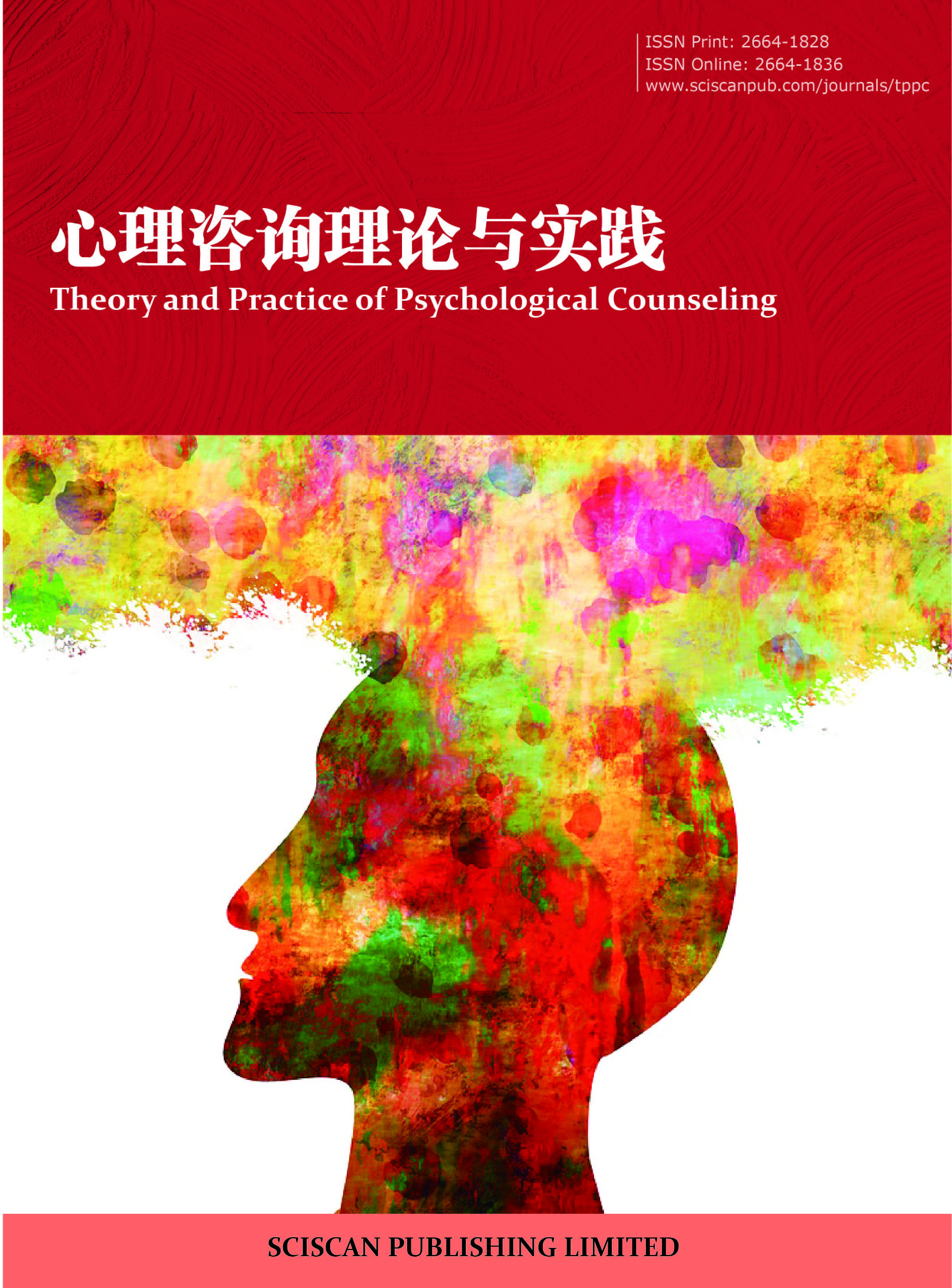Theory and Practice of Psychological Counseling
中国成人抑郁症患者的病耻感:一项基于现象学的质性研究
Stigma Among Chinese Adults with Depression: A Phenomenological Qualitative Study
- Authors: 彭文琪¹ 张颖懿² 李川² 汪作为² 刘子潇¹
-
Information:
1. 上海大学社会学院,上海; 2. 上海市虹口区精神卫生中心,上海
-
Keywords:
Stigma; Depression; Qualitative research; Phenomenology; Chinese adults病耻感; 抑郁症; 质性研究; 现象学; 中国成人
- Abstract: Stigma is a pivotal socio-psychological barrier deterring Chinese adults with depression from professional help-seeking, yet its experience is situational rather than static. Drawing on semistructured in-depth interviews with 15 employed adults aged 25 to 55 diagnosed with moderate-to-major depression, this phenomenological study delineates the dynamic contours of stigma and the protective factors that mitigate it. The findings indicate that high stigma manifests as workplace labelling, social withdrawal, self-deprecation, and treatment avoidance; the dynamic experience of low stigma unfolds in three phases: from ignorance to understanding, from avoidance to participation, and from silence to being “seen”. Three interacting protective factors sustain low stigma: individual psychological resilience, supportive sociocultural environments, and accessible, privacy-protected healthcare. The stigma of adult depression patients must be understood within an interactive framework of public stigma and self-stigma; interventions should simultaneously weaken structural stigma and mobilize intersubjective resources. 病耻感被认为是阻碍中国成人抑郁症患者求助的关键社会心理机制,但其体验并非静止,而是随情境波动。本文采用质性研究方法,通过对15名25~55岁的中国成人抑郁症患者的半结构式深度访谈,探究他们病耻感的动态构成与低病耻感的保护因素。研究发现,高病耻感表现为职场标签化、社会关系回避、自我贬低及治疗回避;低病耻感的动态体验则表现为从未知到理解、从逃避到参与、从缄默到“被看见”。个体心理韧性、社会文化环境支持及医疗可及性与隐私保护,是维持低病耻感的三大保护性因素。成人抑郁症患者的病耻感需置于公众污名和自我污名的互动框架中理解,干预需同时削弱结构性污名并激活主体间性资源。
- DOI: https://doi.org/10.35534/tppc.0708053
- Cite: 彭文琪, 张颖懿, 李川, 汪作为, 刘子潇. (2025). 中国成人抑郁症患者的病耻感:一项基于现象学的质性研究. 心理咨询理论与实践, 7(8), 472-481.
1 引言
近年来,病耻感(stigma)逐渐成为影响抑郁症患者健康的重要因素,越来越受到研究者和从业者的关注。这一概念最早由Goffman(1963)提出,是指一种使个体偏离社会规范或蒙羞的特征,这种特征导致其被他人贬低、排斥,并丧失社会身份。病耻感主要分为两种:自我病耻感和公众病耻感(Corrigan & Watson,2002)。Link等在修正标签理论中指出,自我病耻感是由公众病耻感内化而成(Link et al.,1989)。中国一项大规模精神病流行病学研究(Phillips et al.,2009)显示,92%的精神障碍患者从未接受过任何形式的专业帮助。Phillips(2013)进一步指出,相较于服务供给不足而言,更关键的障碍在于:一方面,患者普遍回避因心理问题寻求帮助;另一方面,许多卫生专业人员也回避提供心理服务。这一“双向回避”现象正是病耻感在社会层面的集中体现。
中国成人抑郁症终身患病率达3.4%(Huang,2019),而病耻感通常会导致患者讳疾忌医,治疗依从性下降,失去早期诊治的最佳时机,最终导致其生活质量下降(Mascayano et al.,2015;Heijnders et al.,2006)。Yen等在中国台湾地区对247例抑郁症患者进行评估,发现25.1%有高水平的病耻感,而且患者症状越重、教育水平越低,其病耻感越强(Yen et al.,2005)。还有研究发现,中国抑郁症成年患者具有较高的病耻感,且与其文化程度、抑郁和社会支持相关(陈敏 等,2012)。
本研究通过质性研究方法聚焦于成人抑郁症患者,深入探讨其病耻感体验,突出可能的干预路径,为精神健康领域的社会支持体系建设提供理论依据。
2 研究设计
2.1 研究方法
本研究采用质性研究方法。现象学作为其中一种研究取向,指的是研究者对某一概念或现象的生活经验意义的描述,其目标在于让有着某一体验的人反思及诉说这一体验对其而言的意味,并且呈现这些体验的本质(Giorgi,2009),这能够帮助人们了解当代成人抑郁症患者的病耻感体验及其低病耻感的保护性因素。
2.2 研究对象
本研究采用目的抽样法,选取25~55周岁已确诊中度抑郁症(Moderate Depression Disorder,MDD)或重度抑郁症(Major Depression Disorder,MDD)、具备工作经历、正在经历疾痛困扰的患者作为研究对象。该人群社会角色身份相似,均在家庭、职场以及社会发展建设中发挥着重要作用。另外,设置排除标准如下:(1)在成年期(18岁)前被诊断患有抑郁症;(2)在访谈期间仍属于学生身份;(3)拒绝签署书面知情同意书;(4)由于严重症状等情况无法顺利完成访谈。研究团队通过微信推文招募,共计访谈19人次,依据数据饱和原则,最终呈现15名访谈对象。其中5名男性,10名女性;病程5年以下(不含5年)8人,5年及以上7人,如表1所示。
表1 访谈对象基本信息
Table 1 Interviewee basic information
|
编码 |
性别 |
年龄(岁) |
初诊年龄(岁) |
病程(年) |
职业 |
婚姻状况 |
|
N1 |
女 |
31 |
19 |
12 |
白领 |
未婚 |
|
N2 |
女 |
25 |
22 |
3 |
待业 |
未婚 |
|
N3 |
女 |
31 |
24 |
7 |
教师 |
未婚 |
|
N4 |
女 |
28 |
25 |
3 |
白领 |
未婚 |
|
N5 |
女 |
31 |
27 |
4 |
医药销售 |
未婚 |
|
N6 |
女 |
31 |
27 |
4 |
白领 |
未婚 |
|
N7 |
男 |
35 |
30 |
5 |
白领 |
未婚 |
|
N8 |
女 |
38 |
34 |
4 |
白领 |
离异 |
|
N9 |
女 |
39 |
36 |
3 |
护士 |
已婚 |
|
N10 |
男 |
40 |
30 |
10 |
培训教师 |
离异 |
|
N11 |
男 |
42 |
41 |
1 |
日企高管 |
已婚 |
|
N12 |
男 |
47 |
42 |
5 |
白领 |
已婚 |
|
N13 |
男 |
46 |
44 |
2 |
居民区书记 |
已婚 |
|
N14 |
女 |
51 |
37 |
14 |
公务员 |
已婚 |
|
N15 |
女 |
53 |
47 |
6 |
白领 |
离异 |
2.3 数据收集与分析
资料收集运用半结构式访谈。研究团队对15名成年抑郁症患者进行深度访谈,单次时长为60~150分钟,部分患者接受追踪访谈。大部分患者受邀到研究团队所在的精神卫生中心参与访谈;考虑到患者的地域分布及其时间安排限制,部分受访者通过线上访谈形式参与研究。
研究过程中严格遵守研究伦理。正式访谈前,研究者向所有受访者详细说明研究目的、实施流程、潜在获益与风险,以及相关权利和信息保障措施等,并说明访谈时会同步录音。经充分告知后,受访者签署知情同意书。线上访谈过程中,受访者提供电子签名或授权研究者代签。
数据分析采用Nvivo12质性分析软件,严格遵循Colaizzi七步法进行编码与主题提炼:逐字转录访谈录音;研究者反复阅读转录文本以熟悉资料;标记与研究主题相关的意义单元;对意义单元进行系统编码;将编码归纳为更具概括性的主题;通过研究者间讨论与原始资料回溯验证主题的准确性;最终形成具有解释力的核心主题体系。该分析流程确保了研究结果的严谨性与可追溯性。
3 研究结果
通过对访谈数据的主题分析,本研究提炼出三个核心主题及十个子主题,系统描述了当代成年抑郁症患者的病耻感状态。三大主题分别为:高病耻感的负向体验、低病耻感的动态体验、低病耻感的保护性因素。
需要说明的是,研究者在访谈中发现,无法简单地将受访者分为高(强)病耻感和低(弱)病耻感两个群体。这契合了Goffman(1963)对病耻感的理解,它是“情境性互动中的身份体验”,是一种动态的社会身份管理过程。简而言之,抑郁症患者在不同情境中会调整其行为以应对污名,病耻感随之波动。故本章将受访者的病耻感体验分为不同情境下的高病耻感和低病耻感。
接下来将结合受访者的典型陈述对各主题展开分析。
3.1 高病耻感的负向体验
3.1.1 职场中的标签化与歧视
职场是拥有工作的抑郁症患者经受病耻感的主要情境之一。尽管他们只是在病情急性发作期或情绪崩溃时出现短暂的工作能力下降情形,但在职场环境中,他们渐渐会被贴上“能力不足/无法胜任”的标签,遭遇歧视,最终往往会被辞退——管理者通常不会以罹患抑郁为由,而是以其他理由做出辞退决定。所有受访者都曾有一份体面的工作,职场歧视导致他们经历工作身份被剥夺。有5位受访者请过较长的病假(因公司辞退需赔付高额赔偿等),N11:“一直被公司约谈,然后我的老板他也说我觉得你已经没有办法正常工作了,建议就停下来。我在医疗病假期,所以公司不能辞退我,如果辞退是要赔钱给我的。”大部分受访者有委婉的被辞退经历。N4:“突然觉得我的工作变少,每天基本都在摸鱼,我那时觉得是因为淡季,结果两个月后我就被辞退了。跟我说的是疫情减员,但其实就是觉得我没有办法继续胜任工作。”N5:“我最后被开掉的原因是我又出现了躯体化,只能请假在家休息,但我是可以在家里工作的,最后他们找了一个理由把我开掉了。”也有受访者存在被直接辞退的情况,N2:“毕业后有正式工作,我签了长期合同,但是我只工作了5天,就因为严重情绪问题强行离职了。其实公司其他人包括我的上司,对我也是会心怀戒备,不可能完全信任的。”
3.1.2 社会关系中的回避与孤立
在最核心和不可避免的亲属关系互动中,大多数受访者都感受到不同程度的回避。最常见的就是“不理解”。N1:“我爸爸妈妈刚开始就很不理解,他们就说谁不抑郁谁都抑郁,类似于这种话,我还觉得挺难过的。”N8:“他们觉得你很傻,你为什么要去轻生?他们不能理解这件事情,甚至会把抑郁症和精神病归为一类。他们只是知道,但是不理解。”除言语上的不正视外,行动上的不接纳也使受访者感受到较强的病耻感。N3:“我觉得我自己因为我爸妈可能比较忌讳,我在家也不太敢去看。非常的避讳,至今都很避讳,我爸现在把我当时没吃完的药都封得死死的,拿了个泡沫箱,缠了好几卷胶带。”
在非亲属关系互动过程中,受访者同样遭受过回避与孤立。情感亲密关系中的回避行为,让抑郁症患者感受到他人的偏见,进而容易导致关系的破裂。N5:“我跟他说我很难受,说我不舒服的症状,想去医院,没有药,我说你能不能带我去医院,他总是找一个话题回避掉,他拒绝我的求救信号。我问过很多次能不能陪我去回访,他从来不陪我,后来我就跟他分手了。我觉得还是偏见吧。可能他们是正常人,还是觉得你生这个病好像不太认同你。”朋友的不接纳和孤立,也会使受访者病耻感增强,进而导致关系逐渐疏远和断绝。N3:“我没有去跟他们说的欲望,或者是没有跟他们去说这件事的勇气,应该还是会害怕,或者是会顾及周围其他人的一些眼光。”N8:“朋友们会厌烦,觉得你的茧结好了为什么又把它拔下来。但很多抑郁症的人其实就是卡壳了,要是什么事情都能想通,那不存在抑郁了。然后朋友就不再跟你聊天了,所以我会到平台上去找陌生人聊天。”
3.1.3 自我贬低与身份认同危机
病耻感源于患者与“正常人”互动时的身份威胁(如被凝视、排斥),并不会因为互动减少而完全消失;病耻感可能持续存在,甚至内化为自我贬低,致使出现身份认同危机。N2:“可能他们只是普通的好奇,但在那个时候我就会觉得他们戴了一副有色眼镜,觉得大家对我有这样的歧视。平时确实有很多地方受到困扰,就会觉得自己和别人不同,会觉得自己这个病会有病耻感。”原本每月工资过万的高管N11:“在医疗病假期,公司每个月发5000块钱基本工资给我,所以我就觉得自己现在很没用,也不能赚钱,也不能养小孩,就觉得没有了家庭地位。”N14:“最严重的时候感受非常深的就是不被人理解,我甚至就想不如自己得个癌症绝症之类的,旁边的人至少会理解和同情你、关心你,但是你得了抑郁症,人家觉得你在作。”也存在因疾病本身而出现自我贬低的情况。
3.1.4 治疗回避
规避心理评估和拒绝药物治疗等回避治疗的行为,是常见的病耻感表现。因为受访者存在对心理健康问题的社会污名化认知,担心被贴上“脆弱”或“异常”的标签,所以容易出现规避行为。N9:“我觉得如果那个时候去做了测试,我会有耻辱感。怎么说,就觉得别人会认为你为什么心理承受不住,别人都没事。所以我当时规避去测试的原因就是这样。”拆药盒和拒药的行为,则更直接地反映出受访者担心被贴上“精神疾病患者”的标签,他们对社会污名化的恐惧强于对医疗权威的信任。N12:“处方开了,没吃那药,我都带着了。吃药的效果可能更好一些,但这都是假设嘛,不吃药慢一点也能走得出来。带在身上可能是有一种保护的作用……我怕别人发现,把药盒拆了放在别的里面。不能接受盒子上面那几个字。”N8:“对吃药是有排斥性的,这是我唯一排斥的东西。我的ID就是‘靠意志力战胜抑郁症’,我不吃药,认为自己很牛。作为病人,有的时候医生说的话是具有权威性的,但可能要说到我心里去让我信服才行。”
3.2 低病耻感的动态体验
3.2.1 从未知到理解:疾病祛魅与自我再定义
最初觉察到自身情绪和身体状况的变化,受访者会通过各种渠道(网络、科普书籍等)尝试理解自己的不适,在这个过程中不断学习抑郁症知识,能较大程度上减轻了对疾病的未知恐惧和病耻感,同时增强了主动求救的意愿。N9:“网上查了一些,就是说还是可以治愈的,或者是可以控制好的,所以比较积极治疗。”N13:“我查过,我都看过,我愿意去自救,我会不断地去学习,我是一个很有自学能力的人。”访谈过程中多次提到“黑狗”比喻的N7:“看过一些书和电影纪录片等等,看怎么正面去面对,像丘吉尔在自传中就将抑郁称为心里的黑狗。”
有不少受访者在被诊断前饱尝自我怀疑和无力感的折磨,诊断后通过正确的疾病归因,从“被动受害者”转向“主动管理者”,显著降低病耻感。例如,从“我是失败者”转向“我是患者”,破除错误归因,削弱自我贬低,从而提升自我接纳度。N10:“第一次去的时候很紧张,但拿到结果之后,医生证明了我是有病的,这让我有一种轻松的感觉。不是我不学好,是我生病了。”再如,明确病因,降低失控感,增强康复信心,减少了因无力感而衍生的病耻感。N3:“当时确诊的时候,我觉得是有一点开心的,因为难受了这么长时间,终于找到原因了,就感觉是可以治疗的,可能会好的这种感觉。”N6:“确诊才知道自己身体真的是很难受,生病的原因就找到了,后面就开始接受治疗。我就觉得它是个病,跟感冒一样,跟我的老鼻炎一样。”
3.2.2 从逃避到参与:治疗参与中的自救与牵绊
与治疗回避不同,患者的高治疗主动性带来的是良性循环:拥有较强的恢复动机的患者主动参与治疗,使其具备更为合理的疾病认知(如将抑郁视作需要治疗的病),随着治疗意愿增强,病耻感逐渐降低。他们的恢复动机主要有两种:一种是源于自身困扰,想要早治疗早康复。N8:“我没有很多情绪,我要解决问题。我就想早点把这个很难受的东西解决掉,把它搞定。”另一种更为重要的是源自家庭牵绊,不想影响自己的孩子和家庭生活。前面存在治疗回避行为的N9在这种牵绊下选择了主动治疗,她说:“会有跳楼的念头,想到家庭,有小孩有父母,就觉得不应该这样……有一次在栈桥边,感觉跳下去是个不错的感觉,后来又觉得我妈和儿子在旁边,不能这样。回来之后我就觉得我想去治疗。”N10:“我的逻辑是这样的,如果说我过不好我自己的生活,他就会失去一个完整的父亲。养育者的形象一定是完整的,哪怕我常年不在他身边,但如果我不在了,对他而言我的形象就不够完整,这对孩子造成的影响最大。”N13:“我孩子现在很好,我担心自己有问题,长此以往不可能对他没有一点伤害,所以我要寻求一个方式让我尽快好起来。”
3.2.3 从缄默到“被看见”:选择性披露中的权衡与支持
选择性披露策略,是抑郁症患者应对病耻感的重要手段,既能减少社会污名压力,又能增强社会支持。正如N7所说:“普遍社会上很多人会戴有色眼镜来看抑郁或各种心理疾病,觉得这是一个不正常的人,但对这方面有点了解的,相对就会客观一点,会给你正向积极的引导。”N3:“很多人对这个病有病耻感,我倒没有那么强,可能就是我觉得一个人如果值得信任的话,在聊天的时候就会顺口说出来这个事。只跟我唯一的朋友也就是那个同事说了。”N9:“(跟儿子)说得比较隐晦,就稍微提了一下我有这样一个病,但是在慢慢地积极治疗,我说应该能够治好,他没什么特别的表现,就知道了。男孩子心思没那么细腻,但他还比较乖,不会让我过多操心。”N15:“我一确定病情就告诉我领导,他也理解。所以我觉得现在没有人会对(抑郁)说什么。”
3.3 低病耻感的保护性因素
3.3.1 个体心理韧性
尽管受访者处于多源病耻感压力情境中,且前述访谈文本呈现出高病耻感的外显特征(如N9对心理测评的回避、N12对药盒的排斥),但受访者并未觉察病耻感,并自动将潜在病耻感体验转化为心理弹性资源,故主观病耻感体验呈现低水平。N9:“我觉得我的心比较大,我也不会很在意别人去说这些事情。”N12:“我当时想给自己弄个精神类疾病然后病退,有一个医生跟我比较熟,跟我讲过,要是这样病退了以后怎么弄,但我不在乎这个事情。”值得注意的是,治疗时长的累积效应,也可能促进从对抗走向接纳的心理转变,展现其心理韧性的保护作用。N1:“它一直都在,我不介意这件事情,我和自己生病其实有一点和解了,我觉得只要自己掉进去的时候,通过自己或别人的帮助,积极地把自己救出来就好了。”
高心理韧性个体往往能主动采取积极应对方式,来缓解抑郁症的痛苦和由此衍生出的自我病耻感(如认为自己没用)。这些方式因人而异,可能是运动、记录等。N6:“我以前特别不爱运动,基本上不动,生病这段时间就是简单的走动都对我帮助挺大的。例如看天空比看天花板有用。”N15:“改变坐的位置和状态,哪怕在小区里走一走。我很喜欢美食,我的第一步就是先去吃,找到自己喜欢的事情去做。”N10:“我会写日记,发现一点的时候就把它写下来,时间长了了解到自己是什么样的,那就知道怎么调整会更好,调整之后慢慢就能放下。我最近写日记都是以这句话为标题,叫——哇,又活了一天,我好厉害。把当下撑过去就可以了。”
高心理韧性所展现的积极心态,使受访者能够看到疾病的另一面,即通过减少自我否定,增强自我肯定,以获得心理能量。N13:“人总要生毛病,身体的毛病是毛病,这就不是毛病吗?而且越是这个毛病,你越是能接受,越是说明你这个人到了一个层次。”N3:“抑郁的情绪包括焦虑对于人来说都是很正常的。这种情绪对人的成长来说也是应该会存在的,不能抹杀掉它们。”N8:“它在不停地让我去寻找活着的价值。它会让我对这个世界的很多东西好奇,我因为这个病去看了很多书。”N15:“我觉得是好事,我想通透了,好多问题是在得抑郁症以后想通的。”
3.3.2 社会文化环境的支持性
家人理解、朋友陪伴,提供实质性帮助,督促就医和治疗,这样营造的低病耻感社会环境对抑郁症患者而言,无疑是强有力的支持。N9:“我的家人和朋友都是比较理解我的,给了我蛮大的动力。”N14:“我感觉我的家人也在努力地理解我。确实很难理解,但是出于对我的爱,他们在努力想理解。”N15:“家人都知道,我主要跟我母亲说我这种状态,她非常开明,就说你应该去看病,甚至后来这一次发作的时候,我不想去看病,他们都劝说你不能这样了,快去专科医院看。”N2:“我出院后和他分手了,但他对我的关心指导一直持续到现在,他在我生命过程中其实是非常重要的一个角色。”N5:“有几次爽约心理咨询,我老板知道了,他就以工资的名义督促我,说如果你不去我就不给你发工资了,他其实是为了我好。”
来自病友群体的支持,因经历相似而更容易产生共情和共鸣。在坦诚的交流互动中,抑郁症不再被视为“不能说”的秘密,病耻感被稀释;孤独感随之减轻,疾病适应力随之增强。抗药多年的N8:“为什么现在会听一下,就是因为我建了自己的账号之后会有很多病友过来交流,我印象比较深刻的是,有个人过来跟我说的第一句话‘我病了8年了,但是我朋友也抑郁症,吃药半年就好了,你要不听我一句,你尝试吃一下’。可能作为同病例的人,他讲述自己的经历可能更丰富生动,所以我是被他说服了。”N4:“我会选择去给我的病友打电话,我潜意识里会觉得这样(一直想跳楼)不行,再这样下去我真的会不行,我就会给别人打电话,给每一个我觉得能听我讲讲话的朋友打电话。”N15:“团体课真的非常好,小伙伴们在一起,他产生一种情绪,好像你没有,你就很想去帮他,大家会互帮互助。”
3.3.3 医疗可及性与隐私保护
互联网的普及让抑郁症知识触手可及,线上问诊、熟人转介、单位关怀等多条路径,共同降低了就医门槛。N8:“我在网上咨询了几位心理医生,他们给我的建议都是去看一下。”N5:“我老板认识胡医生,他看出我不对就让我去看,胡医生就把他的师傅介绍给我了,然后我就在他那边看好的,当时基本上每个礼拜都去随访。”N9:“后来有可能单位领导听说了,比较关心就来家里看我,给我推荐王院长(某精神卫生中心院长),然后就到这边看,院长也比较重视,就帮我安排了……最近我爸生病,我妈很焦虑,也失眠,我约了她下周到院长这边来看,包括我邻居他也是失眠,让他来这边看的效果都很好,可以给他们比较好的指引,就是现身说法。”与此同时,精神卫生机构严格的隐私保护措施(如病历不留痕)为患者提供安全感,进一步削弱病耻感,提升治疗依从性。N7:“来这边看病,病历卡上不会有记录,在病人隐私保护这一方面做得蛮好的。”
4 讨论
4.1 动态病耻感
本研究将Goffman的“污名互动论”置于成人抑郁症患者的职场—家庭—医疗多重情境中加以检验,发现病耻感并非稳定的个人特质,而是一种随互动场景切换而波动的身份管理过程。当患者处于绩效导向的职场或家属期待浓厚的家庭场域时,公众病耻感被迅速激活,并被经验化为“能力不足”“不合格”等负向标签(结果见3.1.1-3.1.3);而当场景转换到病友互助团体或患者具备独立思考能力时,同样的个体又能调用“疾病祛魅”“选择性披露”等策略,使病耻感显著下降(结果见3.2.1-3.2.3)。这一发现呼应Link等修正标签理论关于“污名内化为自我概念”的论述(Link et al.,1989),同时提示“内化”并非单向、线性,而可能因情境线索的即时变化而被“再外化”。也就是说,个体与社会互动中的角色扮演、自我呈现和印象管理等,对于处理污名而言至关重要。
4.2 中国职场情境的特殊性
Prizeman等人指出,年轻抑郁患者通过保密获得掌控感,却因此牺牲了与他人的真正互动(Prizeman et al.,2024)。本研究的职场成人样本进一步揭示:保密策略在中国语境下不仅是心理控制手段,更是“职业生存技术”。例如,N4病情披露后虽没有直接被辞退,但雇主逐步在工作任务上将其边缘化,最终以“疫情”为由辞退。许多原本拥有体面工作的受访者,在因遭受不同程度的职场歧视后,开始采取选择性披露的方式——向谁披露,披露多少——以保住自己的工作身份。例如,N3在职场中只跟自己信任的同事兼朋友透露了病情。尽管这样的做法削减了他们的社会互动,但这其实是他们对抗病耻感的行动。这说明,抑郁症患者能够判断哪些人群值得信任,并通过主动透露病情来获取支持,这是他们应对病耻感的主动选择。
Perry等人指出,相较于儿童抑郁,成人抑郁不被社会严肃对待(Perry et al.,2007)。在能力和绩效优先的中国职场中,成人抑郁同样不会受到重视,反而是被视为“脆弱”的表现。正如受访者N14发出的感叹,“得癌症会被同情,得抑郁则被视为矫情”。由此可见,中国成人抑郁患者在职场环境中可能面临较大的绩效压力,这种压力可能加剧病耻感。
4.3 社会事实视角下的结构性困境与“主体间性”干预切口
本文受访者自述的病耻感程度与其叙事过程中所呈现的高水平病耻迹象之间存在明显张力。换言之,个体层面的自我耻辱感较低,但公众耻辱感作为一种外在于个体的结构性压力,他们尚缺乏有效手段对此施加干预。由此,必须正视抑郁病耻感干预的两大取向:
一方面,公众耻辱感本质是一种社会事实。正如Durkheim(1897)强调的,社会事实外在于个体意识,却深刻约束个体行为。在本研究中,公众病耻感是一种由制度安排(缺位的病假与隐私保护)、群体互动(职场排斥、亲属回避)与文化符号(抑郁=脆弱=矫情=“作”)共同构成的社会事实。由于这一结构性事实的稳定性远高于个体认知的更新速度,纯粹科普干预通常难以动摇其根基。将互联网情境下的认知变迁置于社会结构约束中,可见病耻感既是心理问题,又是社会事实再生产的结果。
另一方面,“主体间性”能够降低自我耻辱感。本文现象学数据提示:当患者与关键他者(医生、雇主、病友)建立“主体间性”关系时,污名脚本可被局部改写。具体表现为:(1)医患主体间性——医生以非评判态度提供科学叙事,帮助患者完成从“我是失败者”到“我是病人”的归因转换;(2)职场主体间性——管理者不再只关注绩效,而是在团队里营造心理安全的氛围(如,N5的老板以“扣发工资”逼其就医,客观上成为治疗推手);(3)病友主体间性——病友通过互助团体共享经验,发挥个人价值;通过算法推荐,形成病友社群,由此实现在线共情和康复叙事,降低自我污名。
本文的研究结论可以得到如下实践启示:未来干预不应仅聚焦个体心理韧性,而应从“削弱结构”和“激活主体”两处发力,遏制歧视性话语与制度性污名的再生产。同时珍视患者社群的疗愈潜能,主要包括三个层面:制度层面,可在《中华人民共和国精神卫生法》实施细则中增设“匿名就医”相关条款,防止病历外泄成为求职隐性门槛;组织层面,医院可在候诊区播放康复者自述短片,门诊医生用“抑郁就像高血压”等通俗比喻替代病理标签,精神科医师和社工督导确保病友互助团体的专业性与安全性。另外,在企事业单位推广心理健康领导力培训,重视员工的情绪困扰;数字层面,社交平台可对“抑郁”“自杀”等关键词,增设康复故事与科普内容的加权算法,降低猎奇与污名化帖子的可见度,从而将网络场域从“围观痛苦”转向“分享希望”。
4.4 研究局限
本研究存在以下两方面局限,需在结果解读与后续研究中予以关注:
首先是样本自选择偏倚。本研究采取自愿报名方式招募受访者,愿意接受访谈的个体很大程度上具有相对较低的抑郁症病耻感。因而,可能导致对高病耻感负向体验的呈现不够全面,研究结果在推论至整体抑郁症患者群体时需谨慎。
其次是数据收集与方法的单一性。研究采用半结构式访谈获取质性资料,虽然有助于深入理解病耻感的具体体验和低病耻感的动态机制,但缺乏大样本的量化验证。后续研究可结合标准化量表或问卷调查,补充并检验本研究发现,从而提高结论的外推性和客观性。
5 结论
病耻感并非成人抑郁症患者的固有特质,而是在职场、家庭与医疗场域中持续协商的流动身份体验。本研究提示,只要社会仍将抑郁等同于“能力不足”或“脆弱”,污名就不会因个体科普而消失;只有当制度、组织与数字空间各方面共同削弱结构性污名,个体韧性才足以展开。未来干预应超越患者个体治疗的单一逻辑,转向同步改造规则与激活关系的双重路径:让抑郁可以被言说,而不必被标签定义。
参考文献
[1] Goffman, E. (1963). Stigma: notes on the management of spoiled identity. Englewood Cliffs: Prentice Hall.
[2] Corrigan, P. W., & Watson, A. C. (2002). The paradox of self-stigma and mental illness. Clinical Psychology Science and Practice, 9(1), 35-53.
[3] Link, B. G., Cullen, F. T., Struening, E., et al. (1989). A modified labeling theory approach to mental disorders: an empirical assessment. American Sociological Review, 54(3), 400-423.
[4] Phillips, M. R., Zhang, J. X., Shi, Q. C., et al. (2009). Prevalence, associated disability and treatment of mental disorders in four provinces in China, 2001-2005: an epidemiological survey. The Lancet (British Edition), 373, 2041-2053.
[5] Phillips, M. R. (2013). Can China’s new mental health law substantially reduce the burden of illness attributable to mental disorders? The Lancet (British Edition), 381, 1964-1966.
[6] Huang, Y. (2019). Prevalence of mental disorders in China: a cross-sectional epidemiological study. The Lancet Psychiatry, 6, 211-224.
[7] Mascayano, F., Armijo, J. E., & Yang, L. H. (2015). Addressing stigma relating to mental illness in low-and middle-income countries. Frontiers in Psychiatry, 6(38), 1-4.
[8] Heijnders, M., & Van Der Meij, S. (2006). The fight against stigma: an overview of stigma-reduction strategies and interventions. Psychological Health and Medicine, 11(3), 353-363.
[9] Yen, C. F., Chen, C. C., Lee, Y., et al. (2005). Self-stigma and its correlates among outpatients with depressive disorders. Psychiatric Services, 56(5), 599-601.
[10] 陈敏, 赵相英, 王爱琴, 周玉萍, 闫景新, 翟金国. (2012). 抑郁症患者的病耻感和社会支持研究. 济宁医学院学报, 35(6), 405-406, 409.
[11] Giorgi, A. (2009). The descriptive phenomenological method in psychology: A modified Husserlian approach. Pittsburgh PA: Duquesne University Press.
[12] Prizeman, K., McCabe, C., & Weinstein, N. (2024). Stigma and its impact on disclosure and mental health secrecy in young people with clinical depression symptoms: A qualitative analysis. PloS One, 19(1), e0296221.
[13] Perry, B. L., Pescosolido, B. A., Martin, J. K., et al. (2007). Comparison of Public Attributions, Attitudes, and Stigma in Regard to Depression Among Children and Adults. Psychiatric Services (Washington, D.C.), 58(5), 632-635.
[14] Durkheim, E. (1897). Suicide: A Study in Sociology (J. A. Spaulding & G. Simpson, Trans.). Glencoe, Illinois: The Free Press of Glencoe.
















